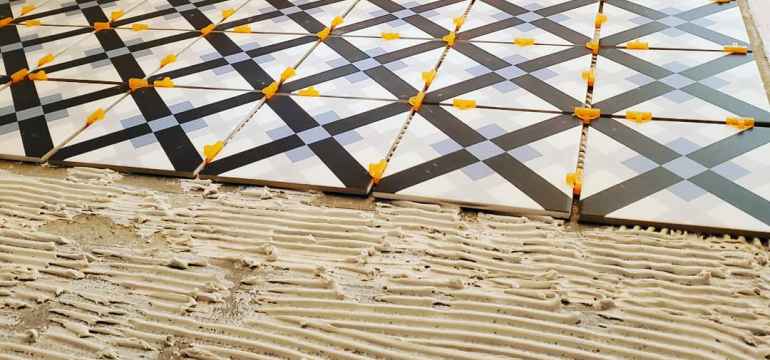When you’re getting ready to install tile, you’ve got a lot of decisions to make—and we’re not just talking about design choices. You’ve got to select the type of backer board and mortar or thinset you’ll use to secure those tiles to the desired surface, such as a wall or floor.
As you shop for the supplies you need, you’ll encounter various kinds of thinset, or mortar, including some varieties that are modified and others that aren’t. Explore the differences between modified vs. unmodified thinset, and then decide which one may be the right choice for your upcoming tile project.
What Is Thinset?

Thinset is a type of adhesive mortar often used to affix stone or tile to various surfaces, especially concrete or cement flooring. Thinset is usually composed of fine sand, cement, and a chemical agent that retains water. This water-retaining agent is typically an alkyl derivative of cellulose. Plus, thinset may have a polymer or latex additive in the mix to improve its bonding power.
You might use thinset to install tile flooring in your home, or you may apply it outside if you’re creating an eye-catching tile design along the edge of a pool or as a decorative mosaic. Thinset works well over cement/fiber board as well as actual cement. You can also apply it over waterproofing membranes. The thinset is the glue that causes the tiles to adhere to the backer board or the other underlying surface that you’re using.
What Is Modified Vs. Unmodified Thinset?
What’s the difference between modified and unmodified thinset mortar? It’s simple, really. Regular unmodified thinset is very basic in its composition, consisting of only the fine sand, a water retention agent, and a portion of cement. Just those three components qualify it as an unmodified thinset.
As previously mentioned, some types of thinset include additives to improve their adhesive qualities and sticking power. If anything beyond the three basic components is included in the thinset, it becomes “modified thinset.” So the inclusion of dry polymers, synthetic latex, and other similar elements identifies the product as modified thinset rather than the basic, unmodified kind.
The modified thinset available from modern suppliers usually incorporates dry polymers that activate when you introduce water. Modified mortar can be used in very thin layers without losing that bonding strength. In addition to offering a more durable bond, modified thinset doesn’t shrink as much as unmodified mortar, and therefore it doesn’t lead to as many tile cracks in years down the road.
When to Use Unmodified Thinset
If you’re planning to apply a Prodeso Installation Membrane or a similar product before laying tile, you’ll need to go with the basic, unmodified thinset. The unmodified thinset works well with the membrane, using its natural moisture to create interlocking bonds for security and durability. If you’re installing radiant floor heating or a similar type of flooring, unmodified is probably your best bet.
When to Use Modified Thinset
For other projects, modified thinset is usually the way to go. Modified thinset relies on other additives besides the basic water retention agents, so moisture is essential to activate those extra additives and created the interlocking crystals that secure the bond between tile and concrete or backer board. The longer that moisture is in play, the stronger the bond becomes. Modified thinset requires air in order to cure properly, and it’s important to allow for thorough curing time.
Once the material has had enough time to cure, you’ll be rewarded with a long-lasting, solid, durable bond between tile and backer board or concrete.
Grades of Thinset
The levels or grades of the different types of thinset are determined by the amount of cement used in the mixture. For example, thinset with a higher ratio of cement to sand is better and more durable. The more sand is present, the less durable the product will be. You’ll need to identify what level of staying and binding power you need for your project, and then select a grade or level of thinset that will offer the bond strength you want.
Choose high-quality modified thinset, with a grade or level that ensures a greater amount of cement compared to sand. That way, you’ll have sticky, corrosion-resistant, long-lasting product to use on your walls or floors.
When you’re mixing thinset, start slowly, so you don’t spray the fine powder everywhere. Mix it until it is the consistency of peanut butter or cake frosting, then spread it in the area where you plan to apply the tiles or other flooring.
Be sure not to mix up too large a batch of thinset at once, because it will begin to harden within twenty minutes to half an hour, and you won’t be able to work with it at that point. So to avoid waste, mix it up in small batches. When you’re done applying the thinset and the tile, sit back and admire your work!
- How to Cut Lexan - September 25, 2020
- Mineral Spirits vs. Mineral Oil - September 25, 2020
- Shellac vs. Polyurethane - September 24, 2020
